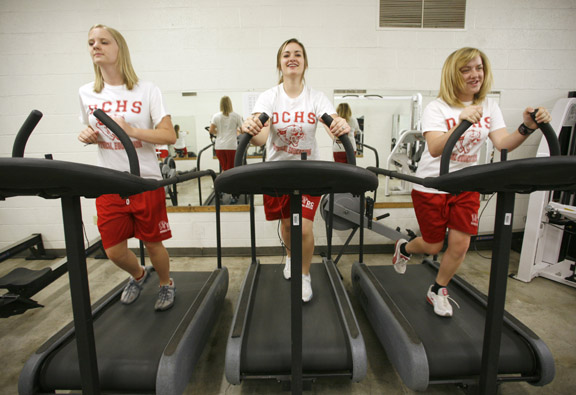
Freshman Jenny McIntosh, left, Jerrika Combs, center, and Emily Wink use treadmills that were donated to Daviess County High School by a local hospital as part of the district’s Graduation 2010 program. The program, which was originally designed to expose students to the arts, has grown to include components such as music, foreign language, literacy, critical thinking, physical and emotional health, and family and community involvement. Photo by Amy Wallot
By Susan Riddell
It started out as an idea to introduce students to critical thinking beyond what traditional textbooks and lessons offer.
Now it’s a part of who they are.
Graduation 2010, an effort created by the Daviess County school district in the fall of 1997, was intended to expose students to the arts, especially those who might not get those opportunities outside the school setting. But it went beyond that, according to Superintendent Tom Shelton.
“Elements of Graduation 2010 have become embedded into our district identity,” Shelton said. “The arts, music, foreign language, literacy, critical thinking, physical and emotional health, family involvement and community involvement are no longer specifically categorized as ‘Graduation 2010 programs,’ but rather are just a part of who we are and how we educate kids.
“When Graduation 2010 was introduced (by former Daviess County Superintendent Stu Silberman), our goal was to provide enhanced opportunities to students who might not otherwise experience exposure to the arts,” Shelton added. “Brain research indicated a direct correlation between learning music and high academic achievement.”
Graduation 2010 not only incorporates the arts into classroom learning, it also gets the community involved. A local business in Owensboro sponsors each graduating class. Owensboro Medical Health System sponsored the class of 2010.
“Class sponsors have provided all kinds of things,” said Jana Beth Francis, director of assessment, research and curriculum for the district. “Each one is very different. Most provided T-shirts when the students were kindergarteners. Each sponsor has provided unique opportunities based on the resources they have. Owensboro Medical Health System gave all the seniors a pedometer at graduation. Unilever, the makers of Ragu, did lessons with 3rd-graders about label design and nutrition. Each student took home a bottle of spaghetti sauce with a label they had created. Kentucky Wesleyan (College) has offered tickets to various sporting events.”
Each fall, this program kicks off throughout the district and includes all grade levels. Younger students are introduced to music and other art elements. The class of 2010 was introduced to keyboarding at the start of the project, but at that time, putting each student in front of a keyboard was a relatively new and expensive concept for schools to pull off successfully. These days, it’s more the norm in Kentucky elementary schools, and as Francis pointed out, it’s standard practice in Daviess County and considered traditional in art education. Intermediate and exiting primary students soon learn chess and other games that meet the critical thinking component of Graduation 2010.
During the early years of Graduation 2010, teacher Cathy Englehardt was tasked with teaching students chess even though she didn’t know much about the game herself.
“At the time (in 1998), I didn’t know how to play and couldn’t imagine how I was going to teach my 5th-graders to play,” said Englehardt, who was at East View Elementary School at the time and soon got a friend to teach her how to play one weekend.
Unable to find teaching material, Englehardt decided to create her own by breaking the game into small steps and gradually helping students master it. The result was Teaching Chess in the Classroom, a document about many facets of the game including rules, history and etiquette.
“We learned the movement or pathways of one piece at a time,” Englehardt said. “We started with the pawns as these are the less complicated pieces to learn. We practiced pathways of each individual piece over and over again. One piece was placed on the board at a time to battle and attack the opponent’s army and king. We gradually increased the number of pieces on the board until all 16 pieces were on the board. This was a slow process, but very productive. Students caught on quickly.
“We learned a little about the history of chess and the symbolism behind each game piece,” Englehardt added. “After researching professional chess matches, I set rules and regulations in the classroom when playing chess to create an orderly and chess-like atmosphere. It was extremely important to the learning process to set and teach behavioral expectation while the chess boards were out. Otherwise, the student energy level becomes difficult to handle, learning is less productive, and game boards and pieces can easily become lost or destroyed. This is a key element to teaching chess successfully in the classroom.”
She concluded the chess instruction with a chess championship. Parents also were brought in to play against their children at PTO events, and several students eventually taught their parents how to play the game.
“It seemed like the learning became contagious,” Englehardt said. “I believe breaking the game down into baby steps removed the barriers to learning and any fear of failure. It was exciting to see students become enthusiastically engaged in learning to play chess.”
Learning through Graduation 2010 continued into middle and high school with a wide variety of learning opportunities. An emphasis in health education was a key component of the high school curriculum, and various class sponsors funded several items students needed to excel in this area.
So with the class of 2010 recently graduated, did Graduation 2010 work?
“Yes,” Francis said. “It established a common philosophy across the district and engaged our community in the schools. Our academic achievement rose as measured by (Commonwealth Accountability Testing System) CATS, but it’s hard to isolate that increase as a direct result of Graduation 2010. As so many other initiatives were involved, we can’t really isolate it to show the direct impact.”
Francis said the name of the initiative will likely change since the class of 2010 has graduated, but the philosophy will remain the same. “Many of the strategies are now just part of our regular program,” she said.
“We continue to focus our vision on preparing students to succeed for life,” Shelton added. “Our innovative experiences with Graduation 2010 have been very successful in giving children the tools to learn in different ways. This initiative has challenged us to look at what students need to know, and be able to do, upon graduation from high school.
“Skills that have been identified as crucial for success include critical thinking, problem-solving, teamwork and communication. It’s not enough to teach kids what to think; we have to teach them how to think. The elements of Graduation 2010 have provided a seamless transition to this focus on 21st-century skills.”
MORE INFO …
Tom Shelton, tom.shelton@daviess.kyschools.us, (270) 852-7000




Leave A Comment